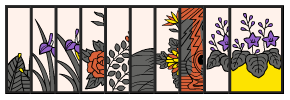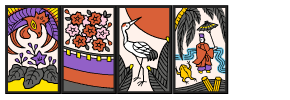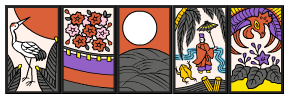This week I learned
a little more about the point system of the game. Well before you start the
game you have to check your hand for any automatic points. The combinations
that you can get 6points are four cards of the same suit or four pairs of cards
with the same suit. When this happens that round ends and the person with that combination in their hand gets the points.
(all
of the same suit) 6pts



 (four
pairs of cards) 6pts
(four
pairs of cards) 6pts








To make the combinations called “yakus”.
The players make a match with another
card on the field which then they would take it or they drop a card if need be
if no matches are available. Then they pick up a card from the draw pile and
see if it can make a match and take it for a possible combination. If it doesn’t
then they leave it on the playing field. Here are the possible yaku’s:
Kasu (Plains)
10 Plain cards. 1 point. Each Additional 1P after.
Tanzaku (Ribbons)
5 Ribbons. 1 point. Each Additional 1P after.
Tane (Animals)
5 Animals. 1 point. Each Additional 1P after.
Ino-Shika-Cho (Boar-Deer-Butterfly)
Animal cards of Clover, Maple, Peony. 5 points.
Akatan (Red Poetry Ribbons)
All 3 red poetry ribbons. 6 points.
Aotan (Blue Ribbons)
All 3 blue ribbons. 6 points.
Sanko (3Brights)
3 Bright cards not containing Rain man card. 6 points.
Ame-Shiko (Rain man)
4Brights containing Rain man card. 8 points.
Shiko (4Brights)
4 Bright cards not containing Rain man card. 10 points.
Goko (5Brights)
All 5 Bright cards. 15 points.
Tsuki-fuda (Monthly Cards)
All four cards in one group shown right on screen. 4 points.
Bake-Fuda (Wild Card)
The
animal card of Chrysanthemum can be regarded as a plain card as well.
If you have this, 9 plain cards and this card will be the Yaku of Kasu.
Oya-Ken (Dealer's Privilege)
If neither gets any Yaku, Dealer wins 6 points.
If during the game a player
calls “stop” then they gain all the points from his or her hand. While the
opponent loses all of the points. If a player has a total of 7 or more points
when the round ends then their score doubles. If a player calls “koi-koi” and
their opponent gets a yaku before them then the opponent’s score is doubled. If
a player is able to score 7 or more points plus getting a yaku when their
opponent called “koi-koi” then their score is quadrupled. this continues for either 6 or 12 rounds and at the end all the points are counted up and the player with the most points wins.
 This
week I downloaded a free koi koi Hanafuda app that is available on the android
market. When you first open the app you have to tap to go to the main menu. There
are four buttons on the main menu which is Battle, Results, Settings, and Help.
This
week I downloaded a free koi koi Hanafuda app that is available on the android
market. When you first open the app you have to tap to go to the main menu. There
are four buttons on the main menu which is Battle, Results, Settings, and Help. The Battle page
has 6 samurai that you have to beat in order. What I think is cool about this
is that each of the samurai opponents were warriors or leaders in japan. For visuals
they put paintings of each each one and their family crest or Mon. I know this
crest is called a mon because our family has our own mon that has been passed
down through a couple of generations. I don’t know the details of my family
crest so I will look into it and give an update next week. As for the
difficulty of each opponent it wasn’t that hard to beat them even if you are a
beginner. Also on this page there is a blue tooth option so you can connect to
other people with the same app. For the results button it shows the statistics
of all the games you have played against the 6 samurai which include the number
of battles, wins, losses, and average. The settings just give you options to
turn on/off some point options in the game, sound, and rounds. The help button
briefly explains what the point of hanafuda is, gives the yaku combinations,
the opponents in the game, and how to quit the game. I beat the game rather
quickly but its good practice for beginners.
The Battle page
has 6 samurai that you have to beat in order. What I think is cool about this
is that each of the samurai opponents were warriors or leaders in japan. For visuals
they put paintings of each each one and their family crest or Mon. I know this
crest is called a mon because our family has our own mon that has been passed
down through a couple of generations. I don’t know the details of my family
crest so I will look into it and give an update next week. As for the
difficulty of each opponent it wasn’t that hard to beat them even if you are a
beginner. Also on this page there is a blue tooth option so you can connect to
other people with the same app. For the results button it shows the statistics
of all the games you have played against the 6 samurai which include the number
of battles, wins, losses, and average. The settings just give you options to
turn on/off some point options in the game, sound, and rounds. The help button
briefly explains what the point of hanafuda is, gives the yaku combinations,
the opponents in the game, and how to quit the game. I beat the game rather
quickly but its good practice for beginners.























